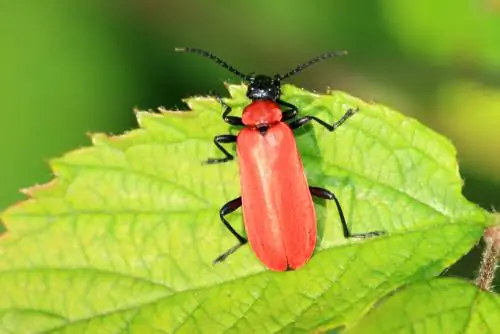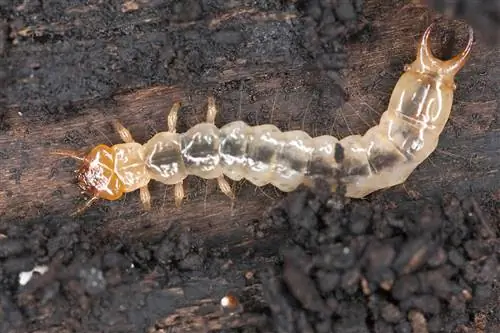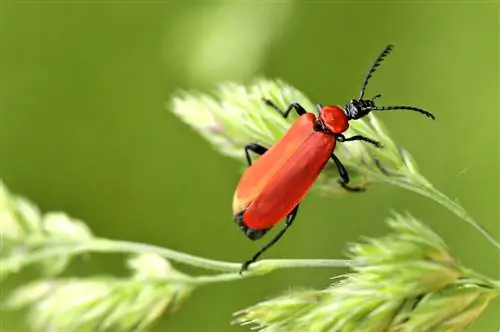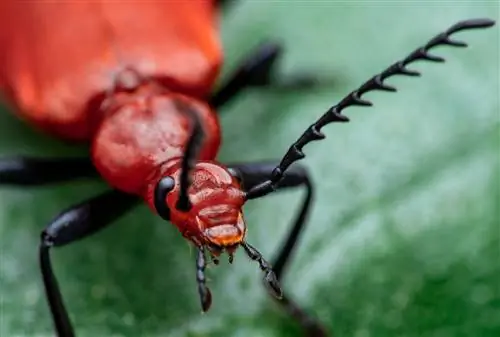- Author admin [email protected].
- Public 2023-12-16 16:46.
- Last modified 2025-01-23 11:22.
Fire beetles are exciting creatures that specialize in very specific habitats. The insects fly in the summer months. They are very often confused with similar species, which leads to misunderstandings. You should therefore only initiate control measures once you have precisely identified the species.
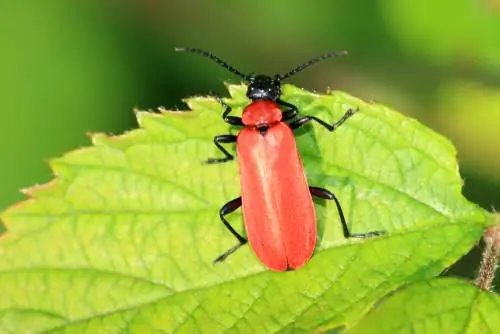
Is control necessary?
Destructing fire beetles only makes sense in the event of specific damage. If your plants are damaged, the cause should be addressed. Since the adult beetles do not feed on living tissue but only consume plant juices and nectar, there is no need to worry about your garden. It is therefore not necessary to eliminate the insects. This also applies to the larvae, because they feed exclusively on wood-dwelling insects and fungi. If you want to get rid of fire beetles, you are endangering the natural balance.
Fire beetles are completely harmless and anything but harmful. On the contrary: they even help to keep the ecosystem in balance.
Be careful when using chemical agents
There are numerous home remedies that can be used against annoying insects. In addition to deterrent substances such as coffee grounds, there are also more aggressive methods that kill the pests. However, most agents do not work selectively. They kill all insects that come into contact with the substances. If you fight aphids, fire beetles can also be harmed. Therefore, pay attention to which substances you use in the garden and whether they can harm useful creatures.
How home remedies work:
- Oil: prevents oxygen absorption
- Soap: causes dehydration
- Fragrances: confuse or frighten
Poisonous and dangerous?
All three species of fire beetles that you can find in nature are completely harmless. The beetles are unable to injure human skin because they do not have mouthparts for biting or stinging. The larvae also pose no danger to humans. Only conspecifics have to be careful if the insects tend to cannibalism.

Be careful of fiery red insects?
There are numerous species in the animal kingdom that warn potential predators with their striking coloring. Bright red colors often indicate that the animal is poisonous. But there are also insects that have only taken on the external appearance of dangerous species. Fire beetles are one of them. Their color is said to be a deterrent, even though the insects do not produce any toxic substances. They are also not toxic to children or responsible for a sudden rash.
In the house
If a fire beetle accidentally gets into your apartment, there is no need to panic. The animals are probably more scared than you. Make sure the insect returns to its natural habitat quickly. Use a glass that you place over the animal. You can then slide a piece of paper under the glass and get the beetle into the glass. Release it at the edge of the forest or on dead wood.
Harmful or useful?
Firebugs don't become a pest. They do not spread en masse and cannot be described as pests. Adult beetles are not dangerous to plants because they do not feed on plant tissue and therefore do not leave any damage.
They only feed on plant juices that are secreted by flowers or come out through open wounds on trees. Living trees are not visited to lay eggs. The larvae develop in dead wood and do not feed on plant tissue.
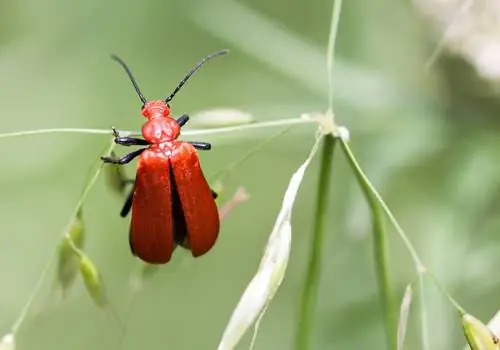
Fire beetles do not harm plants
Prevent fungal spread
The insects are often found near plants infested with aphids. As a result, they often give the impression of being a plant pest, but they are not targeting the plant. Much more attractive are the sweet secretions of aphids, which fire beetles prefer to eat.
Fire beetles protect your plants. Honeydew often provides good living conditions for sooty mold fungi. If the plant is completely covered in the excretions of the sap-sucking lice, its photosynthesis performance can be extremely limited. Fire beetles free the plants and ensure that no fungi can settle on the sticky mass.
Eliminate unwanted insects
The larvae are predatory and hunt for other insect larvae. These are killed and sucked out. Although cannibalism can also occur, the larvae primarily target non-specific larvae. Bark beetle larvae are often on their menu. That's why fire beetles are among the most valuable beneficial insects when it comes to combating bark beetles.
That's why bark beetles are dangerous:
- drill tunnels into the bark of he althy trees
- lay eggs in the breeding tunnels
- can multiply en masse during long periods of heat and drought
- cause pure spruce stands to die
What do fire beetles eat?
Adult fire beetles rarely eat. They feed exclusively on sweet juices such as flower nectar or tree sap. The honeydew from aphids is a particularly tasty addition to the diet.
Larvae eat various fungi that grow in dead wood. They also feed on other insect larvae that they find beneath the bark and in dead wood. When there is a food shortage, cannibalism can be observed. However, this is only the exception and occurs more often when the conditions are no longer optimal. Drought often leads to more developed larvae eating younger generations.
The fire beetle in portrait
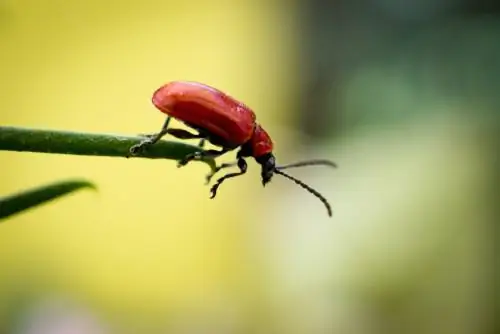
The fire beetle is also called a cardinal
Fire-colored beetles are a family of insects whose scientific name is Pyrochroidae. They belong to the order of beetles and are sometimes referred to as cardinals. The family includes around 140 species worldwide, eight of which are native to Europe. Only three species live in Central Europe. The flight period of the species found in Central Europe is limited to a short period between May and June. When a thunderstorm approaches, the beetles seek shelter in the vegetation.
Fire beetles prefer to fly in this weather:
- calm
- high relative humidity
- Temperatures above 20 degrees Celsius
General characteristics
Cardinals are between three and 20 millimeters long, with their bodies appearing flat and elongated. The upper side is finely hairy, which only becomes visible under the microscope. Almost all species are colored red to brick red.
What is striking is the large and flat head, which is constricted at the transition to the neck and merges into a narrow pronotum. In contrast to other beetles, the temples of fire beetles are clearly visible. The actual wings are protected by cover wings, which are widened towards the back and, in some species, have longitudinal grooves.
Mating
Insects reproduce in spring. Some fire beetles use the chemical compound cantharidin to find a suitable mating partner. This natural substance is said to have an aphrodisiac effect, as males are said to appear more attractive to females due to a particularly high cantharidin content. However, fire beetles cannot produce this attracting pheromone themselves. They absorb the natural substance when larvae suck out dead insects. However, the smell has a deterrent effect on many other insects.
Development
The females usually lay their eggs under the bark of dead deciduous trees. Here the larva hatches under protected conditions in self-dug or foreign tunnels. It has a very flattened body and displays predominantly predatory behavior.
Insects and their larvae are part of the diet of fire beetle larvae. But they also feed on fungi that have settled in the dead wood. The larvae pupate between the wood and bark and after two to three years crawl to the surface as adult beetles. Under favorable conditions, adult beetles develop after just one year.
Where do fire beetles live?
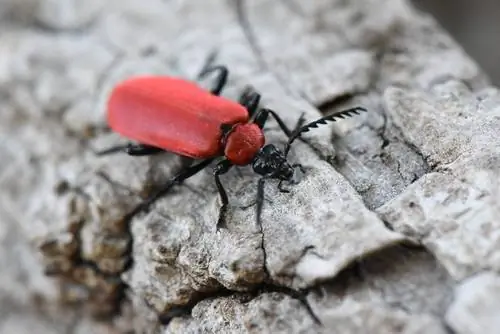
Fire beetles need dead wood for their larvae
Fire beetles inhabit forest edges and forests where deciduous trees dominate. The more natural the forest, the better the insects can spread. They rely on dead wood, which hardly exists in forests used for timber purposes. In monocultures, which consist predominantly of conifers, fire beetles do not find suitable living conditions.
Your larvae need woody material that is already in an advanced stage of decay. This offers protection and high humidity, which the larvae depend on. If the wood is uncovered, the larvae escape into moister cracks in the wood or into deeper layers of bark.
A herb-rich understory with flowering plants is also important because adult fire beetles get their food from the flowers. Nectar-producing herbaceous plants are important. Fire beetles do not stay on flowers that do not have nectar to offer.
These trees are preferred:
- Oak
- Linde
- Birch
Wintering
Adult fire beetles do not overwinter. Their sole reason for existence is mating, which occurs shortly after hatching between May and June. As soon as this is completed and the eggs have been laid, the animals die. Only their larvae overwinter under the bark of dead trees. How often the larvae overwinter depends on factors such as the weather and food availability. It usually takes one or two winter periods before they pupate.
Whether the larvae are active in winter probably depends on the conditions. The more protected and isolated the habitat, the more active the larvae are. At what temperature the insect larvae die is not known, at least for the native species.
Excursus
Dendroides canadensis
This species from the fire beetle family, native to North America, amazed researchers. They extracted special proteins from the larvae that act as natural antifreeze. The water molecules move much slower when they are near these antifreeze proteins. The calmer the movements of the water molecules, the lower the temperatures can fall until water turns into ice.
When ice crystals have formed, the proteins dock to the crystal surface and prevent further growth of the microscopic ice lumps. Because of these mechanisms, the larvae of this fire beetle are able to survive temperatures down to minus 30 degrees Celsius.
Species
The species-rich family contains 21 genera. There are three species native to Central Europe that inhabit very similar habitats. It is not uncommon for larvae of different fire beetle species to live together under the bark of dead trees. They look very similar and can easily be confused with each other.
Scarlet Fire Beetle (Pyrochroa coccinea)
This species is between 13 and 18 millimeters long. The body is flat and wide. The wing cover and pronotum are bathed in strong red tones, while the rest of the body shines in a deep black. If you look closely, you can see a brown-red glow on the forehead. The claw on the legs is also striking, as it is reddish-brown in the scarlet fire beetle.
Their flight period is from May to June. This species is comparatively common and also occurs in the southern and central parts of Scandinavia. It inhabits forest edges and clearings and is often found on dead wood and flowers.
| male | Female | |
|---|---|---|
| Sensor | combed from the third link | completely sawn |
| Size | 13 to 17 mm | 14 to 18 mm |
Red-headed fire beetle (Pyrochroa serraticornis)
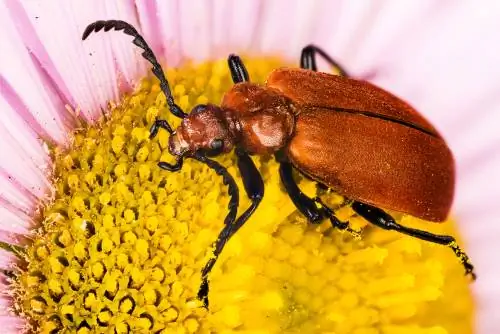
The red-headed fire beetle is slightly smaller than its relative with the black head
This beetle is slightly smaller than the scarlet fire beetle, as it is only between ten and 14 millimeters long. There are similarities in the coloring of the pronotum and wing cover, as these are also colored red in Pyrochroa serraticornis. The most important difference is the red head color, which gave this species its name.
Good to know:
- occurs in temperate regions of Europe
- mainly in Central Europe
- lives on the edges of forests and in clearings
- significantly rarer than the scarlet fire beetle
Orange Fire Beetle (Schizotus pectinicornis)
This beetle is the smallest of all fire beetles native to Europe, reaching a maximum body length of nine millimeters. The pronotum is slightly rounded on the sides and has a black spot. The cover wings have flat longitudinal ribs, which are, however, very weak. Both parts of the body are colored orange-red while the rest of the body is black. This species can also occasionally be observed under the bark of spruce and pine trees.
Distribution:
- large parts of Europe up to above the Arctic Circle
- mainly deciduous forests
- especially in the foothills and mountains
Identify larvae
All three native species lay their eggs on dead wood. The larvae live under the bark and look very similar. Some body characteristics are used to identify the species. The distribution also gives an indication of the species, even if the areas often overlap.
| Scarlet Fire Beetle | Red-headed Fire Beetle | Orange Fire Beetle | |
|---|---|---|---|
| Abdominal appendages | just | just | curved |
| Base of attachments | toothed | toothed | toothless |
| Antennas | slim | strong | insignificant |
| Coloring fresh beetles | light brown red | light brown red | light yellowish-brown |
Confusion with other species
Fire beetles are often confused with similar-looking species. Various characteristics help to distinguish the animals from one another. These can also be seen with the naked eye.
This is how the species differ:
- Coloring of the elytra
- Body shape
- piercing-sucking mouthparts of beaked beaks
- chewing mouthparts in beetles
Common fire bug
This species is not a beetle. Fire bugs are a separate family that belong to the order of beaked bugs. The insects are therefore only distantly related to the fire beetles, which fall into the order of beetles. The German common names are incorrectly used synonymously. Fire bugs are popularly referred to as fire beetles and vice versa.
However, the respective species can be easily distinguished if you look a little closer. Fire bugs have a typical color pattern. Their elytra are colored red with black dots and triangles. Fire bugs often occur in large clusters and inhabit open habitats such as cemeteries with deciduous trees.
Lily Chicken
This plant pest belongs to the leaf beetle family and is characterized by a sealing wax red coloring of the pronotum and elytra. This means that the lily cockerel can easily be confused with fire beetles, but these insects only reach a body length of between six and eight millimeters.
There are further differences in lifestyle and diet. These false fire beetles specialize in lilies. They lay their eggs on the undersides of leaves. The hatched larvae feed on the leaves like the adult insects. They pupate in the soil.

Firebugs in the garden
Since fire beetles do not cause any damage and their larvae even prove to be useful, it makes a lot of sense to specifically settle the animals in your own garden. To do this, you have to design the living conditions so that the beetles find enough food, places to retreat and places to lay their eggs.
If you want to redesign your garden accordingly, you should take the insects' lifestyle as a guide. The more natural the habitat, the more attractive the garden is to the fire beetles. You don't need a lot of space to create an oasis. You can also create new living spaces on the balcony with small changes.
Deadwood
Dead wood is a valuable habitat for numerous organisms. In Central Europe, more than 1,300 different species of insects live on old and dead wood. This includes the larvae of the fire beetle. This variety of insects attracts numerous songbirds and woodpeckers, which feed on the insects. To create such a species-rich oasis in the garden, you can use old wood. Fallen trees, dead roots or fallen branches make excellent dead wood.
Pile the material in a corner of the garden or spread it evenly over the area. Fire beetle larvae thrive in particularly thick trunks that are already in an advanced stage of decomposition. There is high humidity in rotten wood, which the larvae depend on.
This is what the ideal pile of dead wood looks like:
- Dig a pit
- layer up rough pieces of branches, tree slices and roots
- Fill leaves and brushwood into the gaps
Tip
Pay attention to the groundwater level and soil conditions! Water should not accumulate in hollows and depressions, as this endangers hibernating animals in the dead wood.
Flower strips
In order to offer the beetles a rich supply of food, you should create species-rich flower strips. You can incorporate these into a lawn. The flowers are preferred when they are not exposed to the blazing sun. Fire beetles like partially shaded conditions that resemble forest edges and clearings.
Tip
Field trees and hedges further enrich the living space. Smaller songbirds also find protection from predators here.
Frequently asked questions
What is the difference between a fire beetle and a fire bug?
Fire bugs belong to a different order than fire beetles. They differ in their coloring. While the common fire bug is colored red and has black markings, the three native species of fire beetles are solid red. Bedbugs have proboscis-like mouthparts that they use for sucking. Fire beetles, on the other hand, have chewing mouthparts.
Why do fire beetles bond?
Many insects combine to mate. However, no compounds that last for several hours or even days can be observed in fire beetles. What is meant here is the common fire bug, which is incorrectly called a fire beetle. Males and females of these insects are often observed in a position in which the two rear ends are firmly connected to each other. Because males want to prevent females from mating with competitors, the connection is sometimes maintained for several days.
Where do fire beetles come from?
The conspicuous insects live in the protection of trees and bushes in the herb-rich underlayer. They prefer bright conditions and often sit on flowers as they feed on nectar. They lay their eggs in dead wood. This is where the larvae hatch, retreating into the damp cracks in the wood and hunting other insect larvae.
It is a misconception that the animals depend on burned wood. However, there is a species called fire beetles that takes advantage of forest fires. Behind this species is the Australian fire beetle.
Lifestyle of the Australian Fire Beetle:
- Egg-laying on smoldering and smoking trunks
- spoon-shaped larvae eat into the wood
- Resin from living trees endangers the development of the larvae
Where did the name come from?
Many fire beetles have striking coloring, ranging from scarlet to black. The bright red was already associated with fire in the past, which is how the beetles got their name. The scientific name is made up of the Greek terms “pyros” for fire and “chroma” for color. The German name is a translation of this name. Fire beetles are also incorrectly called fire bugs, but they belong to a different family.
What do fire beetles need to survive?
The insects are among the creatures that depend on dead wood. Their larvae can only develop in the protection of old wood that is in an advanced stage of decomposition. Inside there is a moist environment that offers optimal growth conditions for fungi. These are vital for the larvae as they are eaten with preference alongside other insect larvae.
What are fire beetles good for?
Fire beetles prove to be useful creatures in pest control. Their larvae hunt other insect larvae that are in the dead wood. The larvae of the dreaded bark beetle are also on their menu. Adult fire beetles feed primarily on sweet plant juices. But the sticky secretions of aphids are not ignored either. In this way, fire beetles ensure that fungi do not spread on the infected plant.

